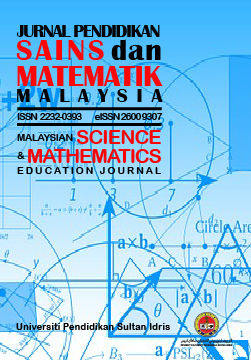Content Validation Procedure: Development of Problem-solving Skills Test (PSST)
Prosedur Pengesahan Kandungan: Pembangunan Ujian Kemahiran Penyelesaian Masalah (PSST)
DOI:
https://doi.org/10.37134/jpsmm.vol13.1.1.2023Keywords:
Content Validity, Content Validity Index (CVI), Problem-solving Skills, Mathematics Education, Validity of InstrumentAbstract
This research aimed at developing a test instrument, the Problem-solving Skills Test (PSST) for Year Four students. The researcher has carried out content validity procedures on the PSST instrument. The content validity of the test involved six content validation experts. There were ten items for the test instrument. The items on the test have been evaluated quantitatively using the Content Validity Index (CVI) to determine whether they should be retained or discarded. According to the findings, the item content validity index, I-CVI, came in at a value of 1.00 for all items. This resulted in the scale content validity index, for both S-CVI/Ave and S-CVI/UA, equal to 1.00. Therefore, the Problem-solving Skills Test (PSST) has attained a very high degree of content validity and may be administered in actual research to determine students’ problem-solving skills.
Downloads
References
Ary, D., Jacobs., L. C., Sorenson, C. K., & Walker, D. (2013). Introduction to research in education (Vol. 8). Cengage Learning.
Curriculum Development Centre, M. of E. M. (2018). Dokumen Standard Kurikulum dan Pentaksiran Matematik Matematik Tahun 4. Putrajaya: Bahagian Pembangunan Kurikulum, KPM.
Davis, L. L. (1992). Instrument review: Getting the most from a panel of experts. Applied Nursing Research, 5(4). https://doi.org/10.1016/S0897-1897(05)80008-4
Lynn, M. R. (1986). Determination and quantification of content validity. Nursing Research, 35(6). https://doi.org/10.1097/00006199-198611000-00017
Martinez, M. E. (1998). What is problem solving? Phi Delta Kappan, 79(8). https://doi.org/10.1177/2325160315576361
Mayer, R. E., & Wittrock, M. C. (2006). Problem solving. Handbook of Educational Psychology, 2, 287–303.
Mohd Rusdin, N., & Dollah, M. U. (2018). Keupayaan menyelesaikan masalah matematik berayat menggunakan strategi melukis gambar rajah dalam kalangan murid tahun 3 Sekolah Rendah. Jurnal Pendidikan Sains Dan Matematik Malaysia, 8(2). https://doi.org/10.37134/jpsmm.vol8.2.8.2018
National Council of Teachers of Mathematics. (2000). Principles and standards for school mathematics. School Science and Mathematics, 47(8).
Polit, D. F., & Beck, C. T. (2006). The content validity index: Are you sure you know what’s being reported? Critique and recommendations. Research in Nursing and Health, 29(5). https://doi.org/10.1002/nur.20147
Polit, D. F., Beck, C. T., & Owen, S. v. (2007). Focus on research methods: Is the CVI an acceptable indicator of content validity? Appraisal and recommendations. Research in Nursing and Health, 30(4). https://doi.org/10.1002/nur.20199
Sutama, S., Anif, S., Prayitno, H. J., Narimo, S., Fuadi, D., Sari, D. P., & Adnan, M. (2021). Metacognition of junior high school students in mathematics problem solving based on cognitive style. Asian Journal of University Education, 17(1). https://doi.org/10.24191/ajue.v17i1.12604
Tuan Siti Humaira, T. H., & Mohamad Amir Shah, A. (2016). Analisis kesalahan Newman dalam penyelesaian masalah matematik tahun 3. Jurnal Pendidikan Sains & Matematik Malaysia, 6(2).
van Zanten, M., & van den Heuvel-Panhuizen, M. (2018). Opportunity to learn problem solving in Dutch primary school mathematics textbooks. ZDM - Mathematics Education, 50(5). https://doi.org/10.1007/s11858-018-0973-x
Waltz, C. F., & Bausell, R. B. (1981). Nursing research: Design, statistics, and computer analysis. Philadelphia: F. A. Davis.
Downloads
Published
Issue
Section
License
Copyright (c) 2023 Farah Aizar Zaipul Bahari, Salmiza Saleh

This work is licensed under a Creative Commons Attribution-NonCommercial-ShareAlike 4.0 International License.





